2020 Hyundai Ioniq Electric tire pressure
[x] Cancel search: tire pressurePage 442 of 561

7-36
Maintenance
All Season Tires
HYUNDAI specifies all season tires
on some models to provide good
performance for use all year round,
including snowy and icy road condi-
tions. All season tires are identified
by ALL SEASON and/or M+S (Mud
and Snow) on the tire sidewall. Snow
tires have better snow traction than
all season tires and may be more
appropriate in some areas.
Summer Tires
HYUNDAI specifies summer tires on
some models to provide superior
performance on dry roads. Summer
tire performance is substantially
reduced in snow and ice. Summer
tires do not have the tire traction rat-
ing M+S (Mud and Snow) on the tire
side wall. If you plan to operate your
vehicle in snowy or icy conditions,
HYUNDAI recommends the use of
snow tires or all season tires on all
four wheels.
Snow Tires
If you equip your car with snow tires,
they should be the same size and
have the same load capacity as the
original tires. Snow tires should be
installed on all four wheels; other-
wise, poor handling may result. Snow
tires should carry 4 psi (28 kPa)
more air pressure than the pressure
recommended for the standard tires
on the tire label on the driver’s side of
the center pillar, or up to the maxi-
mum pressure shown on the tire
sidewall, whichever is less. Do not
drive faster than 75 mph (120 km/h)
when your vehicle is equipped with
snow tires.
Radial-Ply Tires
Radial-ply tires provide improved
tread life, road hazard resistance and
smoother high speed ride. The radi-
al-ply tires used on this vehicle are of
belted construction, and are selected
to complement the ride and handling
characteristics of your vehicle.
Radial-ply tires have the same load
carrying capacity, as bias-ply or bias
belted tires of the same size, and use
the same recommended inflation
pressure. Mixing of radial-ply tires
with bias-ply or bias belted tires is
not recommended. Any combina-
tions of radial-ply and bias-ply or bias
belted tires when used on the same
vehicle will seriously deteriorate
vehicle handling. The best rule to fol-
low is: Identical pairs of radial-ply
tires should always be used as a set
for the front tires and a set for the
rear tires.
Page 443 of 561
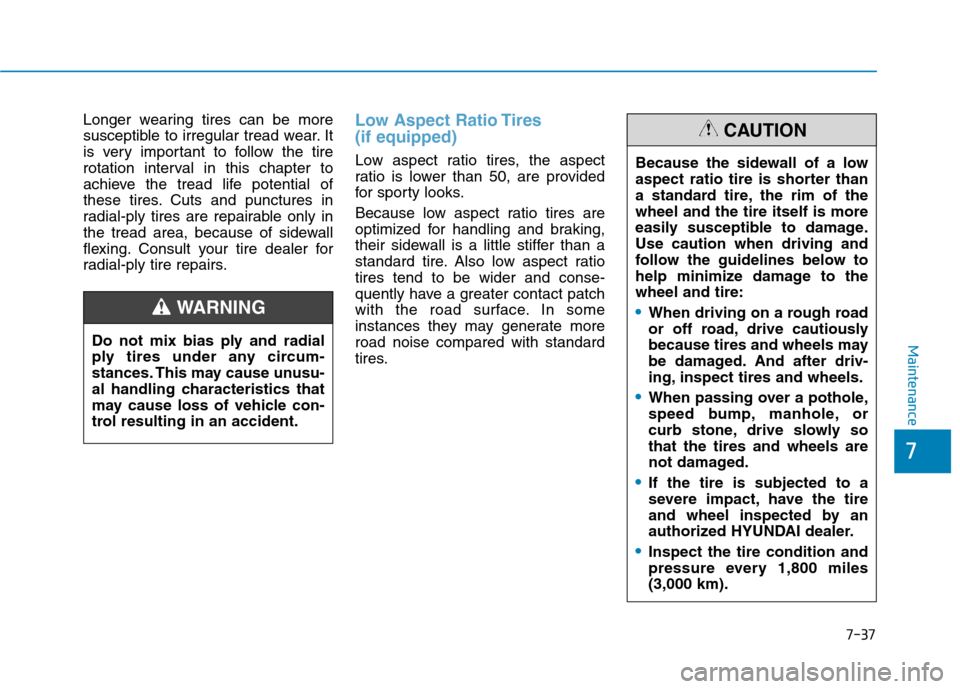
7-37
7
Maintenance
Longer wearing tires can be more
susceptible to irregular tread wear. It
is very important to follow the tire
rotation interval in this chapter to
achieve the tread life potential of
these tires. Cuts and punctures in
radial-ply tires are repairable only in
the tread area, because of sidewall
flexing. Consult your tire dealer for
radial-ply tire repairs.Low Aspect Ratio Tires
(if equipped)
Low aspect ratio tires, the aspect
ratio is lower than 50, are provided
for sporty looks.
Because low aspect ratio tires are
optimized for handling and braking,
their sidewall is a little stiffer than a
standard tire. Also low aspect ratio
tires tend to be wider and conse-
quently have a greater contact patch
with the road surface. In some
instances they may generate more
road noise compared with standard
tires. Do not mix bias ply and radial
ply tires under any circum-
stances. This may cause unusu-
al handling characteristics that
may cause loss of vehicle con-
trol resulting in an accident.
WARNING
Because the sidewall of a low
aspect ratio tire is shorter than
a standard tire, the rim of the
wheel and the tire itself is more
easily susceptible to damage.
Use caution when driving and
follow the guidelines below to
help minimize damage to the
wheel and tire:
When driving on a rough road
or off road, drive cautiously
because tires and wheels may
be damaged. And after driv-
ing, inspect tires and wheels.
When passing over a pothole,
speed bump, manhole, or
curb stone, drive slowly so
that the tires and wheels are
not damaged.
If the tire is subjected to a
severe impact, have the tire
and wheel inspected by an
authorized HYUNDAI dealer.
Inspect the tire condition and
pressure every 1,800 miles
(3,000 km).
CAUTION
Page 479 of 561
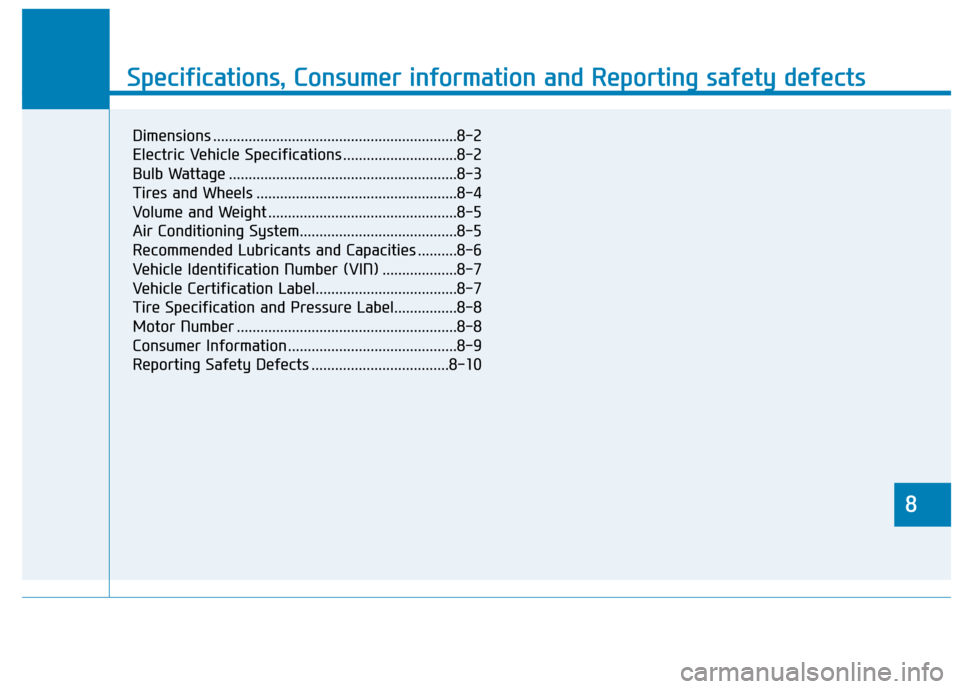
888
Specifications & Consumer information
8
Specifications, Consumer information and Reporting safety defects
8
Dimensions ..............................................................8-2
Electric Vehicle Specifications .............................8-2
Bulb Wattage ..........................................................8-3
Tires and Wheels ...................................................8-4
Volume and Weight ................................................8-5
Air Conditioning System........................................8-5
Recommended Lubricants and Capacities ..........8-6
Vehicle Identification Number (VIN) ...................8-7
Vehicle Certification Label....................................8-7
Tire Specification and Pressure Label................8-8
Motor Number ........................................................8-8
Consumer Information ...........................................8-9
Reporting Safety Defects ...................................8-10
Page 482 of 561
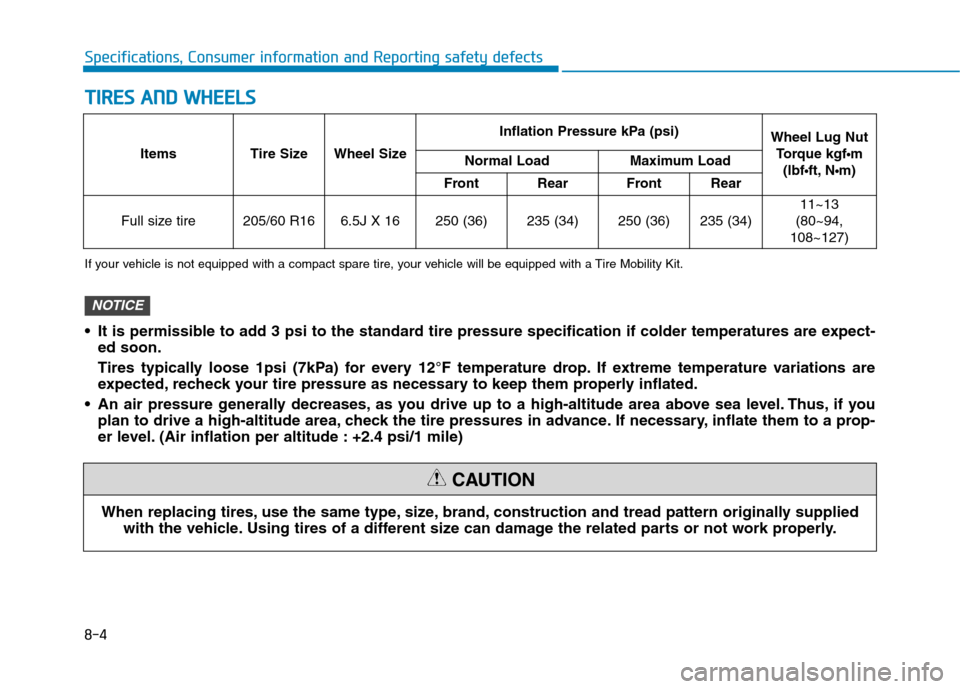
8-4
Specifications, Consumer information and Reporting safety defects
T TI
IR
RE
ES
S
A
AN
ND
D
W
WH
HE
EE
EL
LS
S
When replacing tires, use the same type, size, brand, construction and tread pattern originally supplied
with the vehicle. Using tires of a different size can damage the related parts or not work properly.
CAUTION
If your vehicle is not equipped with a compact spare tire, your vehicle will be equipped with a Tire Mobility Kit.
Items Tire SizeWheel Size
Inflation Pressure kPa (psi)Wheel Lug Nut
Torque kgf
•m
(lbf
ft, Nm)Normal LoadMaximum Load
FrontRearFrontRear
Full size tire205/60 R166.5J X 16250 (36)235 (34)250 (36)235 (34)
11~13
(80~94,
108~127)
It is permissible to add 3 psi to the standard tire pressure specification if colder temperatures are expect-
ed soon.
Tires typically loose 1psi (7kPa) for every 12°F temperature drop. If extreme temperature variations are
expected, recheck your tire pressure as necessary to keep them properly inflated.
An air pressure generally decreases, as you drive up to a high-altitude area above sea level. Thus, if you
plan to drive a high-altitude area, check the tire pressures in advance. If necessary, inflate them to a prop-
er level. (Air inflation per altitude : +2.4 psi/1 mile)
NOTICE
Page 537 of 561
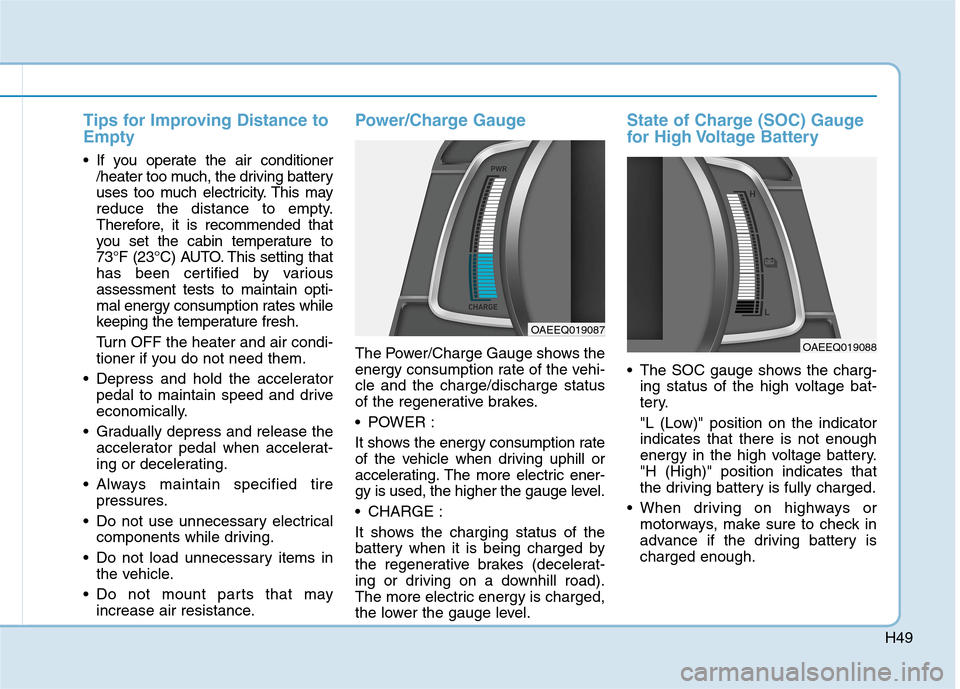
H49
Tips for Improving Distance to
Empty
If you operate the air conditioner
/heater too much, the driving battery
uses too much electricity. This may
reduce the distance to empty.
Therefore, it is recommended that
you set the cabin temperature to
73°F (23°C) AUTO. This setting that
has been certified by various
assessment tests to maintain opti-
mal energy consumption rates while
keeping the temperature fresh.
Turn OFF the heater and air condi-
tioner if you do not need them.
Depress and hold the accelerator
pedal to maintain speed and drive
economically.
Gradually depress and release the
accelerator pedal when accelerat-
ing or decelerating.
Always maintain specified tire
pressures.
Do not use unnecessary electrical
components while driving.
Do not load unnecessary items in
the vehicle.
Do not mount parts that may
increase air resistance.
Power/Charge Gauge
The Power/Charge Gauge shows the
energy consumption rate of the vehi-
cle and the charge/discharge status
of the regenerative brakes.
POWER :
It shows the energy consumption rate
of the vehicle when driving uphill or
accelerating. The more electric ener-
gy is used, the higher the gauge level.
CHARGE :
It shows the charging status of the
battery when it is being charged by
the regenerative brakes (decelerat-
ing or driving on a downhill road).
The more electric energy is charged,
the lower the gauge level.
State of Charge (SOC) Gauge
for High Voltage Battery
The SOC gauge shows the charg-
ing status of the high voltage bat-
tery.
"L (Low)" position on the indicator
indicates that there is not enough
energy in the high voltage battery.
"H (High)" position indicates that
the driving battery is fully charged.
When driving on highways or
motorways, make sure to check in
advance if the driving battery is
charged enough.
OAEEQ019087
OAEEQ019088
Page 560 of 561
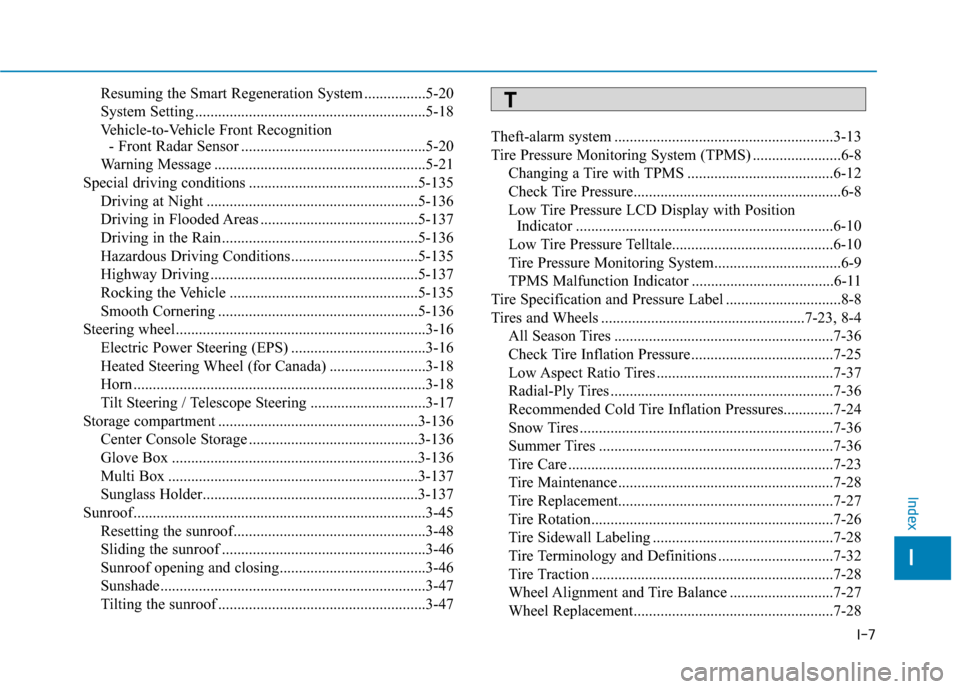
I-7
Resuming the Smart Regeneration System ................5-20
System Setting ............................................................5-18
Vehicle-to-Vehicle Front Recognition
- Front Radar Sensor ................................................5-20
Warning Message .......................................................5-21
Special driving conditions ............................................5-135
Driving at Night .......................................................5-136
Driving in Flooded Areas .........................................5-137
Driving in the Rain ...................................................5-136
Hazardous Driving Conditions .................................5-135
Highway Driving ......................................................5-137
Rocking the Vehicle .................................................5-135
Smooth Cornering ....................................................5-136
Steering wheel.................................................................3-16
Electric Power Steering (EPS) ...................................3-16
Heated Steering Wheel (for Canada) .........................3-18
Horn ............................................................................3-18
Tilt Steering / Telescope Steering ..............................3-17
Storage compartment ....................................................3-136
Center Console Storage ............................................3-136
Glove Box ................................................................3-136
Multi Box .................................................................3-137
Sunglass Holder........................................................3-137
Sunroof............................................................................3-45
Resetting the sunroof..................................................3-48
Sliding the sunroof .....................................................3-46
Sunroof opening and closing......................................3-46
Sunshade.....................................................................3-47
Tilting the sunroof ......................................................3-47Theft-alarm system .........................................................3-13
Tire Pressure Monitoring System (TPMS) .......................6-8
Changing a Tire with TPMS ......................................6-12
Check Tire Pressure......................................................6-8
Low Tire Pressure LCD Display with Position
Indicator ...................................................................6-10
Low Tire Pressure Telltale..........................................6-10
Tire Pressure Monitoring System.................................6-9
TPMS Malfunction Indicator .....................................6-11
Tire Specification and Pressure Label ..............................8-8
Tires and Wheels .....................................................7-23, 8-4
All Season Tires .........................................................7-36
Check Tire Inflation Pressure .....................................7-25
Low Aspect Ratio Tires ..............................................7-37
Radial-Ply Tires ..........................................................7-36
Recommended Cold Tire Inflation Pressures.............7-24
Snow Tires ..................................................................7-36
Summer Tires .............................................................7-36
Tire Care .....................................................................7-23
Tire Maintenance ........................................................7-28
Tire Replacement........................................................7-27
Tire Rotation...............................................................7-26
Tire Sidewall Labeling ...............................................7-28
Tire Terminology and Definitions ..............................7-32
Tire Traction ...............................................................7-28
Wheel Alignment and Tire Balance ...........................7-27
Wheel Replacement....................................................7-28
I
Index
T